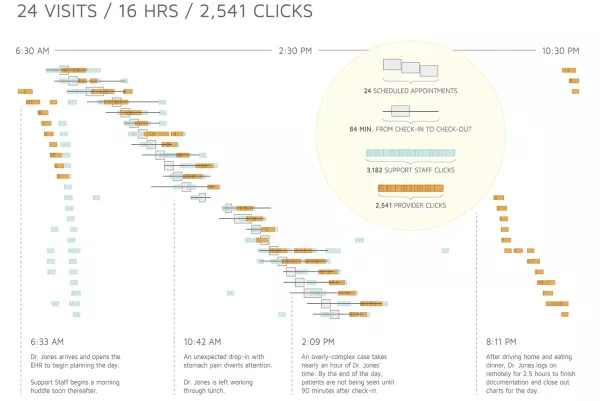A day in the life of “Death by a Thousand Clicks”
On WBUR, three prominent Boston physicians just decried the impact of poorly-designed or poorly-implemented electronic medical records on patient care. Our research into click-level data supports their experiences.
Three prominent Boston-area physicians just contributed an opinion piece to WBUR, “Death By A Thousand Clicks”. When doctors and nurses turn their backs to patients in order to pay attention to computer screen, they argue, it pulls their focus from the “time and undivided attention” required to provide the right care. Multiple prompts and clicks in an electronic health record system (EHR) impact patients — and contribute to physician burnout.
As a healthcare professional uses an EHR, HIPAA requires that EHR to capture click-level detail about records accessed and actions performed. This click-level detail is intended for auditing, but can also be used to identify situations where a provider’s performance — and quality of life — are impacted by an EHR implementation.
A Day in the Life of Dr. Jones
“Dr. Jones” is a pseudonym for a physician whose work day is probably all too familiar to the three authors of the WBUR piece. Over the course of a single day, she has 24 scheduled appointments — which require 16 hours and 2,541 clicks.
This click-level data is embedded deep within the EHR data that Arcadia mines for its customers, and it represents a highly-detailed set of interactions between the provider, support staff, patients and the EHR software itself. Compiling each “click” within the system into a Gantt chart provides an intuitive visual summary of Dr. Jones’ work day. By compiling and analyzing those thousands of clicks, we can see critical operational data like patient wait times, provider efficiency, and documentation distribution.

Dr. Jones starts her workday at 6:30 AM, preparing for a morning huddle with her staff. By comparing the patient’s scheduled visit start time with the first “click” by Dr. Jones, we can see that over the course of the day she gets behind. Patient wait time (and patient dissatisfaction) increase, and Dr. Jones works through lunch to make up for having seen a drop-in patient with stomach pain.
By the end of the business day, Dr. Jones’ patients are waiting 90 minutes to be seen after check-in. Unfortunately, Dr. Jones’ work has not yet ended. She drives home, eats dinner, and then spends hours accessing dozens of EHR modules to close out notes for each visit so that charges can be billed.
How does Dr. Jones compare to her peers?

Each provider is represented by a bubble, with Dr. Jones in orange. The vertical axis represents documentation quality, an area in which Dr. Jones is strong compared to her peers. The horizontal axis represents efficiency (a composite measure of duration and clicks in the EHR per patient). Providers on the left are highly efficient. Here, Dr. Jones struggles relative to her peers. Unsurprisingly, the upper-left quadrant is vacant – capturing high quality documentation is very hard to do in an efficient and timely matter.
Learning from Dr. Jones
Our considerable experience with click-level EHR data corroborates the story that Drs. John Levinson, Bruce Price, and Vikas Saini tell in their WBUR piece. When systems are poorly designed or poorly implemented, it’s not just the patient-provider relationship that suffers — it’s also the provider’s quality of life.
Provider burnout is a significant issue, and one that puts patient access to care and safety at risk. We strongly support Drs. Levinson, Price, and Saini when they say, “The sound of medicine is not the click of a mouse. It is the human voice. Let’s bring it back.”
